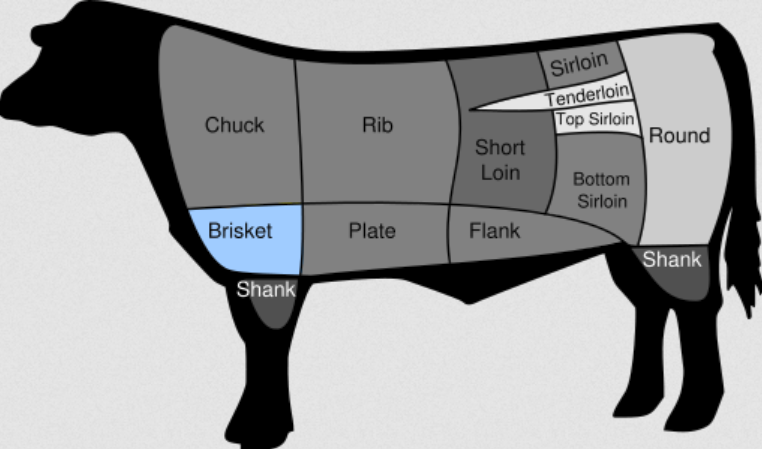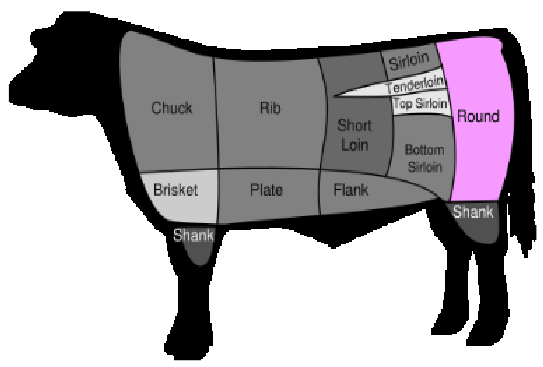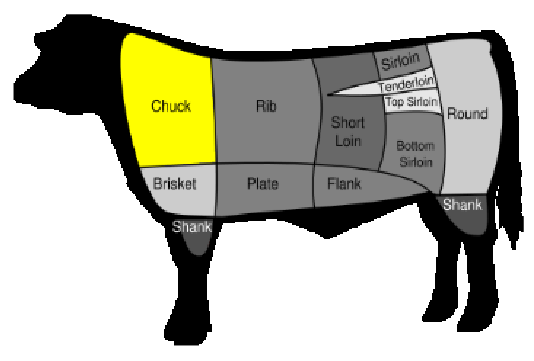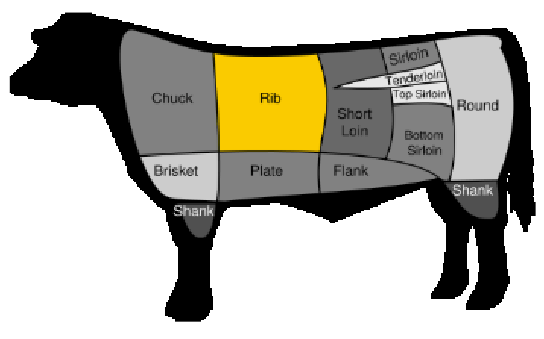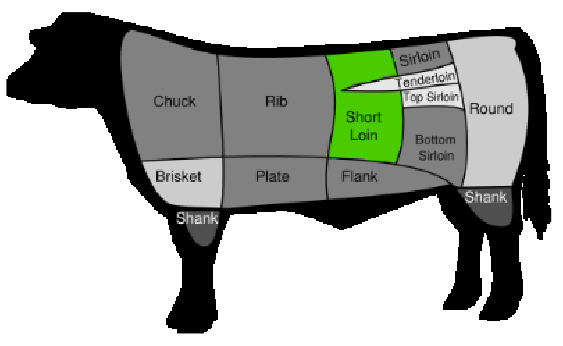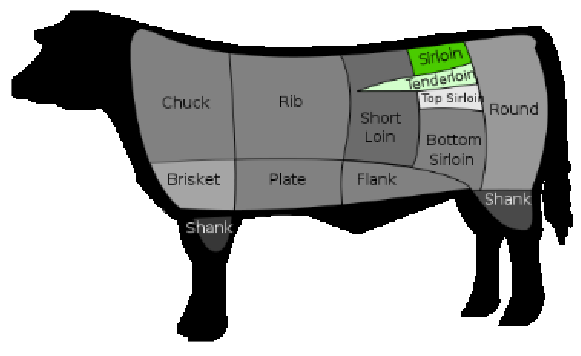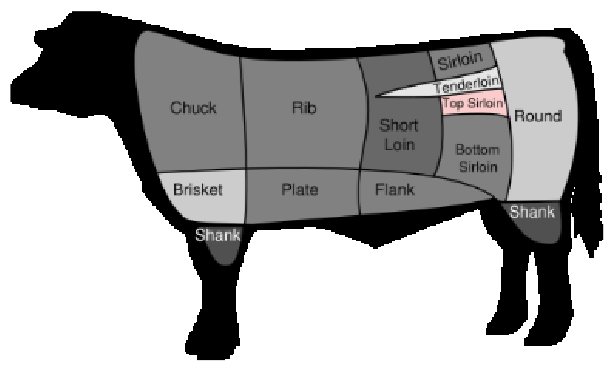4.1: Primal and Subprimal Beef Cuts
- Page ID
- 21242
\( \newcommand{\vecs}[1]{\overset { \scriptstyle \rightharpoonup} {\mathbf{#1}} } \)
\( \newcommand{\vecd}[1]{\overset{-\!-\!\rightharpoonup}{\vphantom{a}\smash {#1}}} \)
\( \newcommand{\id}{\mathrm{id}}\) \( \newcommand{\Span}{\mathrm{span}}\)
( \newcommand{\kernel}{\mathrm{null}\,}\) \( \newcommand{\range}{\mathrm{range}\,}\)
\( \newcommand{\RealPart}{\mathrm{Re}}\) \( \newcommand{\ImaginaryPart}{\mathrm{Im}}\)
\( \newcommand{\Argument}{\mathrm{Arg}}\) \( \newcommand{\norm}[1]{\| #1 \|}\)
\( \newcommand{\inner}[2]{\langle #1, #2 \rangle}\)
\( \newcommand{\Span}{\mathrm{span}}\)
\( \newcommand{\id}{\mathrm{id}}\)
\( \newcommand{\Span}{\mathrm{span}}\)
\( \newcommand{\kernel}{\mathrm{null}\,}\)
\( \newcommand{\range}{\mathrm{range}\,}\)
\( \newcommand{\RealPart}{\mathrm{Re}}\)
\( \newcommand{\ImaginaryPart}{\mathrm{Im}}\)
\( \newcommand{\Argument}{\mathrm{Arg}}\)
\( \newcommand{\norm}[1]{\| #1 \|}\)
\( \newcommand{\inner}[2]{\langle #1, #2 \rangle}\)
\( \newcommand{\Span}{\mathrm{span}}\) \( \newcommand{\AA}{\unicode[.8,0]{x212B}}\)
\( \newcommand{\vectorA}[1]{\vec{#1}} % arrow\)
\( \newcommand{\vectorAt}[1]{\vec{\text{#1}}} % arrow\)
\( \newcommand{\vectorB}[1]{\overset { \scriptstyle \rightharpoonup} {\mathbf{#1}} } \)
\( \newcommand{\vectorC}[1]{\textbf{#1}} \)
\( \newcommand{\vectorD}[1]{\overrightarrow{#1}} \)
\( \newcommand{\vectorDt}[1]{\overrightarrow{\text{#1}}} \)
\( \newcommand{\vectE}[1]{\overset{-\!-\!\rightharpoonup}{\vphantom{a}\smash{\mathbf {#1}}}} \)
\( \newcommand{\vecs}[1]{\overset { \scriptstyle \rightharpoonup} {\mathbf{#1}} } \)
\( \newcommand{\vecd}[1]{\overset{-\!-\!\rightharpoonup}{\vphantom{a}\smash {#1}}} \)
\(\newcommand{\avec}{\mathbf a}\) \(\newcommand{\bvec}{\mathbf b}\) \(\newcommand{\cvec}{\mathbf c}\) \(\newcommand{\dvec}{\mathbf d}\) \(\newcommand{\dtil}{\widetilde{\mathbf d}}\) \(\newcommand{\evec}{\mathbf e}\) \(\newcommand{\fvec}{\mathbf f}\) \(\newcommand{\nvec}{\mathbf n}\) \(\newcommand{\pvec}{\mathbf p}\) \(\newcommand{\qvec}{\mathbf q}\) \(\newcommand{\svec}{\mathbf s}\) \(\newcommand{\tvec}{\mathbf t}\) \(\newcommand{\uvec}{\mathbf u}\) \(\newcommand{\vvec}{\mathbf v}\) \(\newcommand{\wvec}{\mathbf w}\) \(\newcommand{\xvec}{\mathbf x}\) \(\newcommand{\yvec}{\mathbf y}\) \(\newcommand{\zvec}{\mathbf z}\) \(\newcommand{\rvec}{\mathbf r}\) \(\newcommand{\mvec}{\mathbf m}\) \(\newcommand{\zerovec}{\mathbf 0}\) \(\newcommand{\onevec}{\mathbf 1}\) \(\newcommand{\real}{\mathbb R}\) \(\newcommand{\twovec}[2]{\left[\begin{array}{r}#1 \\ #2 \end{array}\right]}\) \(\newcommand{\ctwovec}[2]{\left[\begin{array}{c}#1 \\ #2 \end{array}\right]}\) \(\newcommand{\threevec}[3]{\left[\begin{array}{r}#1 \\ #2 \\ #3 \end{array}\right]}\) \(\newcommand{\cthreevec}[3]{\left[\begin{array}{c}#1 \\ #2 \\ #3 \end{array}\right]}\) \(\newcommand{\fourvec}[4]{\left[\begin{array}{r}#1 \\ #2 \\ #3 \\ #4 \end{array}\right]}\) \(\newcommand{\cfourvec}[4]{\left[\begin{array}{c}#1 \\ #2 \\ #3 \\ #4 \end{array}\right]}\) \(\newcommand{\fivevec}[5]{\left[\begin{array}{r}#1 \\ #2 \\ #3 \\ #4 \\ #5 \\ \end{array}\right]}\) \(\newcommand{\cfivevec}[5]{\left[\begin{array}{c}#1 \\ #2 \\ #3 \\ #4 \\ #5 \\ \end{array}\right]}\) \(\newcommand{\mattwo}[4]{\left[\begin{array}{rr}#1 \amp #2 \\ #3 \amp #4 \\ \end{array}\right]}\) \(\newcommand{\laspan}[1]{\text{Span}\{#1\}}\) \(\newcommand{\bcal}{\cal B}\) \(\newcommand{\ccal}{\cal C}\) \(\newcommand{\scal}{\cal S}\) \(\newcommand{\wcal}{\cal W}\) \(\newcommand{\ecal}{\cal E}\) \(\newcommand{\coords}[2]{\left\{#1\right\}_{#2}}\) \(\newcommand{\gray}[1]{\color{gray}{#1}}\) \(\newcommand{\lgray}[1]{\color{lightgray}{#1}}\) \(\newcommand{\rank}{\operatorname{rank}}\) \(\newcommand{\row}{\text{Row}}\) \(\newcommand{\col}{\text{Col}}\) \(\renewcommand{\row}{\text{Row}}\) \(\newcommand{\nul}{\text{Nul}}\) \(\newcommand{\var}{\text{Var}}\) \(\newcommand{\corr}{\text{corr}}\) \(\newcommand{\len}[1]{\left|#1\right|}\) \(\newcommand{\bbar}{\overline{\bvec}}\) \(\newcommand{\bhat}{\widehat{\bvec}}\) \(\newcommand{\bperp}{\bvec^\perp}\) \(\newcommand{\xhat}{\widehat{\xvec}}\) \(\newcommand{\vhat}{\widehat{\vvec}}\) \(\newcommand{\uhat}{\widehat{\uvec}}\) \(\newcommand{\what}{\widehat{\wvec}}\) \(\newcommand{\Sighat}{\widehat{\Sigma}}\) \(\newcommand{\lt}{<}\) \(\newcommand{\gt}{>}\) \(\newcommand{\amp}{&}\) \(\definecolor{fillinmathshade}{gray}{0.9}\)After the steer is slaughtered, it is cut into four pieces (called quarters) for easy handling. This is done by first splitting the carcass down the backbone into two bilateral halves. Each half is divided into the forequarter (the front portion) and the hindquarter (the rear portion) by cutting along the natural curvature between the 12th and 13th ribs. The quartered carcass is then further reduced into the primal cuts and the sub primal and fabricated cuts.
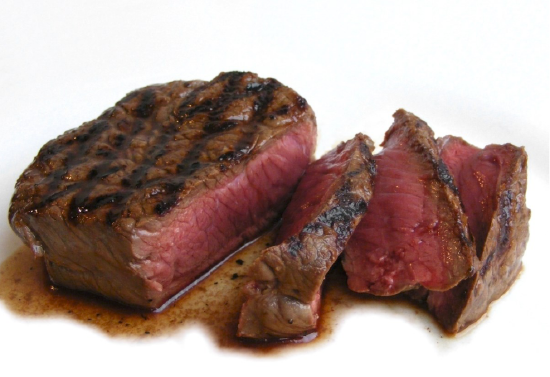
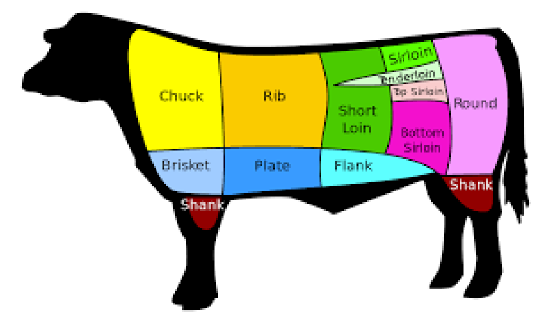
The primal cuts of beef are the chuck, brisket and shank, rib, short plate, short loin, sirloin, flank and round. It is important to know the location of bones when cutting or working with meats. This makes meat fabrication and carving easier and aids in identifying cuts. An entire beef carcass can range in weight from 500 to more than 800 pounds (225 to 360 kg).
FOREQUARTER
Chuck
The primal chuck is the animal's shoulder; it accounts for approximately 28 percent of carcass weight. It contains a portion of the backbone, five rib bones and portions of the blade and arm bones. Because an animal constantly uses its shoulder muscles, chuck contains a high percentage of connective tissue and is quite tough. This tough cut of beef, however, is one of the most flavorful.
The primal chuck is used less frequently than other primal cuts in food service operations. If cooked whole, the chuck is difficult to cut or carve because of the large number of bones and relatively small muscle groups that travel in different directions. The primal chuck produces several fabricated cuts: cross rib pot roast, chuck short ribs, cubed or tenderized steaks, stew meat and ground chuck.
Because the meat is less tender, the fabricated cuts usually benefit from moist-heat cooking or combination cooking methods such as stewing and braising. There are exceptions, however. The beef industry is developing new products from underutilized cuts of meat. Flat iron comes from the top shoulder of the chuck and is one such cut gaining in popularity as an alternative steak suitable for dry-heat cooking.
Cattle is the collective name for all domesticated oxen (genus Bos). Cattle are classified as follows:
- Bulls - male cattle, usually not raised to be eaten.
- Calves - young cows or bulls prized for their meat.
- Cows - female cattle after their first calving raised in this country principally for milk and calf production. In France, cows are used for beef when they are no longer needed for milk.
- Heifers - young cows or cows before their first calving. Heifer meat and organs are becoming increasingly popular as a food source.
- Stags - male cattle castrated after maturity, principally used for dog food.
- Steers - male cattle castrated prior to maturity and principally raised for beef.
BRISKET and SHANK
The brisket and shank are located beneath the primal chuck on the front half of the carcass. Together, they form a single primal that accounts for approximately 8 percent of carcass weight. This primal consists of the steer's breast (the brisket), which contains the ribs and breastbone, and its arm (the fore shank), which contains only the shank bone.
The ribs and breastbone are always removed from the brisket before cooking. The boneless brisket is very tough and contains a substantial percentage of fat, both intermuscular and subcutaneous. It is well suited for moist-heat and combination cooking methods such as simmering or braising. It is often pickled or corned to produce corned beef brisket, or cured and peppered to make pastrami. Beef fore shanks are very flavorful and high in collagen. Because collagen converts to gelatin when cooked using moist heat, fore shanks are excellent for making soups and stocks. Ground shank meat is often used to help clarify and flavor consommés because of its rich flavor and high collagen content.
RIB
The primal beef rib accounts for approximately 10 percent of carcass weight. It consists of ribs 6 through 12 as well as a portion of the backbone. This primal is best known for yielding roast prime rib of beef. Prime rib is not named after the quality grade USDA Prime. Rather, its name reflects the fact that it constitutes the majority of the primal cut. The eye meat of the rib (the center muscle portion) is not a well-exercised muscle and therefore is quite tender. It also contains large amounts of marbling compared to the rest of the carcass and produces rich, full- flavored roasts and steaks. Although roasting the eye muscle on the rib bones produces a moister roast, the eye meat can be removed to produce a boneless rib eye roast or cut into ribeye steaks. The rib bones that are separated from the rib eye meat are quite meaty and flavorful and can be served as barbecued beef ribs. The ends of the rib bones that are trimmed off the primal rib to produce the rib roast are known as beef short ribs. They are meaty and are often served as braised beef short ribs.
SHORT PLATE
The short plate is located directly below the primal rib on a side of beef; it accounts for approximately 9 percent of the overall weight of the carcass. The short plate contains rib bones and cartilage and produces the short ribs and skirt steak. Short ribs are meaty, yet high in connective tissue, and are best when braised. Skirt steak is often marinated and grilled as fajitas. Other, less meaty portions of the short plate are trimmed and ground.
HIND QUARTER
Short Loin
The short loin is the anterior (front) portion of the beef loin. It is located just behind the rib and becomes the first primal cut of the hindquarter when the side of beef is divided into a fore-quarter and hindquarter. It accounts for approximately 8 percent of carcass weight. The short loin contains a single rib, the 13th, and a portion of the backbone. With careful butchering, this small primal can yield several sub primal and fabricated cuts, all of which are among the most tender, popular and expensive cuts of beef
The loin eye muscle, a continuation of the rib eye muscle, runs along the top of the I-shaped bones that form the backbone. Beneath the loin eye muscle on the other side of the backbone is the tenderloin, the tenderest cut of all.
When the short loin is cut in cross-sections with the bone in, it produces - starting with the rib end of the short loin club steaks (which do not contain any tenderloin), T-bone steaks (which contain only a small portion of tenderloin), and porterhouse steaks (cut from the sirloin end of the short loin, and contain a large portion of tenderloin).
The whole tenderloin can also be removed and cut into chateaubriand, filet mignon, and tournedos. A portion of the tenderloin is located in the sirloin portion of the loin. When the entire beef loin is divided into the primal short loin and primal sirloin, the large end of the tenderloin (the butt tenderloin) is separated from the remainder of the tenderloin and remains in the sirloin; the smaller end of the tenderloin (the short tenderloin) remains in the short loin. If the tenderloin is to be kept whole, it must be removed before the short loin and sirloin are separated. The loin eye meat can be removed from the bones, producing a boneless strip loin, which is very tender and can be roasted or cut into boneless strip steaks.
Sirloin
The sirloin is located in the hindquarter, between the short loin and the round. It accounts for approximately 7 percent of carcass weight and contains part of the backbone as well as a portion of the hipbone.
The sirloin produces bone-in or boneless roasts and steaks that are flavorful and tender. With the exception of the tenderloin portion, however, these subprimals and fabricated cuts are not as tender as those from the strip loin are. Cuts from the sirloin are cooked using dry-heat methods such as broiling, grilling or roasting.
Flank
The flank is located directly beneath the loin, posterior to (behind) the short plate. It accounts for approximately 6 percent of carcass weight. The flank contains no bones.
Although quite flavorful, it is a less tender cut with a good deal of fat and connective tissue. Flank meat is usually trimmed and ground, with the exception of the flank steak or London broil. The flank also contains a small piece of meat known as the hanging tenderloin. Although not actually part of the tenderloin, it is very tender and can be cooked using any method.
ROUND
The primal round is very large, weighing as much as 200 pounds (90 kg) and ac- counting for approximately 24 percent of carcass weight. It is the hind leg of the animal and contains the round, aitch, shank and tailbones.
Meat from the round is flavorful and tender. The round yield s a wide variety of subprimal and fabricated cuts: the top round, outside round, eye round (the outside round and the eye round together are called the bottom round), knuckle and shank. Steaks cut from the round are less tender, but because they have large muscles and limited intermuscular fat, the top round and knuckle make good roasts. The bottom round is best when braised. The hind shank is prepared in the same fashion as the fore shank.
Organ Meats
Several organ meats find use in food service operations. This group of products is known as offal. It includes the heart, kidney, tongue, tripe (stomach lining) oxtail, and pigs feet. Offal benefit from moist-heat cooking and are often used in soup, stew or braised dishes.
Nutrition
Beef is a major source of protein and the primary food source of zinc as well as B vitamins, trace minerals and other nutrients. While well-marbled beef does contain a high percentage of saturated fat, lean cuts of beef such as eye round and top round roasts, top sirloin and shoulder pot roast have less fat than chicken thighs, a standard level of comparison. Excess fat should be trimmed as much as possible before cooking and serving.
~Procedures for Butchering~
Although many food service operations buy their beef previously cut and portioned, it is still important for a cook to be able to fabricate cuts of beef and perform basic butchering tasks.
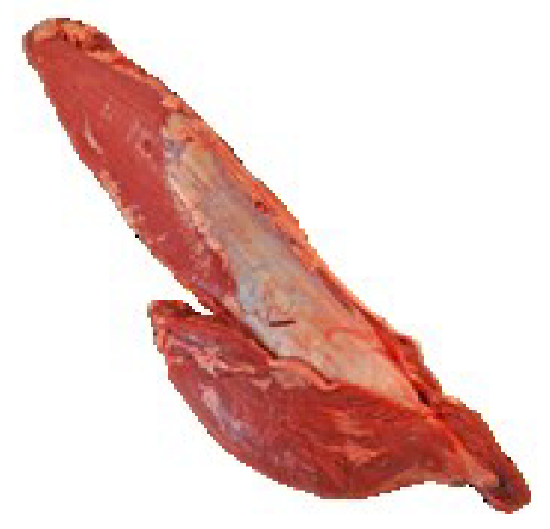
Photo: Pixabay
- Cut and pull the excess fat from the entire tenderloin to expose the meat.
- Remove the chain muscle from the side of the tenderloin. (Although it contains much connective tissue, the chain muscle may be trimmed and the meat used as tenderloin trimmings in various dishes.)
- Trim away all of the fat and silver skin. Do so by loosening a small piece of silver skin; then, holding the loosened silver skin tightly with one hand, cut it away in long strips, angling the knife up toward the silver skin slightly so that only the silver skin is removed and no meat is wasted.
- Cut the tenderloin as desired into (left to right) tips, chateaubriand, filet mignon, tournedos tips, and tenderloin tips.
Many cuts of boneless meats such as tenderloin steaks and boneless pork chops can be butterflied to create a thinner cut that has a greater surface area and cooks more quickly.
- Make the first cut nearly all the way through the meat, keeping it attached by leaving approximately ¼ inch (6 millimeters) uncut.
- Make a second cut, this time cutting all the way through, completely removing the steak from the tenderloin.
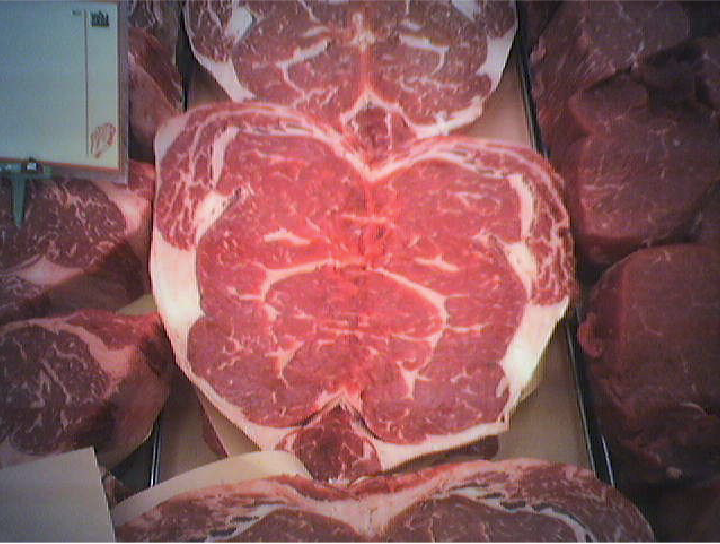
Beef Ribeye butterflied - flickr
| PRIMAL | FABRICATED CUT | IMPS | COOKING METHODS | SERVING SUGGESTIONS |
|---|---|---|---|---|
| Chuck | Top blade (flat iron) | 114D | Dry heat (broil or grill) | Steak; fajitas |
| Chuck roll, tied | 116A | Combination (braise; stew) | Pot roast; beef stew | |
| Stew meat | 135A | Combination (stew) Beef stew | ||
| Ground beef | 136 | Dry heat (broil or grill; roast) | Hamburgers; meat load | |
| Combination (braise; stew) | Chili con came; beef stews | |||
| Brisket and dinner | Brisket | 120 | Moist heat (simmer) | Corned beef; New Eng. boiled |
| Shank | Combination (braise | Pot Roast | ||
| Shank | 117 | Combination (braise) | Shredded beef for tamales or hash | |
| Rib | Oven-ready rib roast | 109 | Dry heat (roast) | Roast prime rib |
| Rib eye roll | 112 | Dry heat (roast) | Roast prime rib | |
| Short Plate | Skirt steak | 121D | Dry heat (broil or grill) | Steak; fajitas |
| Short ribs | 123A | Combination (braise) | Braised short ribs |
\(\dfrac{\text{Forequarter Above}\qquad \qquad \qquad \qquad \qquad \qquad \qquad \qquad \qquad \qquad \qquad \qquad\qquad\qquad\qquad\qquad\qquad \qquad }{\text{Hindquarter Below}\qquad \qquad \qquad \qquad \qquad \qquad \qquad \qquad \qquad \qquad \qquad \qquad \qquad \qquad \qquad \qquad \qquad \qquad }\)
| Short loin | Porterhouse | 173, 174 | Dry heat (broil or grill) | Steak T-bone steaks |
|---|---|---|---|---|
| Strip loin | 180 | Dry heat (broil or grill; sauté) | New York steak; minute steak; roast; borderlaise | |
| Tenderloin | 189 | Dry heat (broil or grill; roast) | Tournedos Rossini; Beef Wellington | |
| Sirloin | Top sirloin butt | 184 | Dry heat (broil or grill; roast) | Steak; roast beef |
| Tri tip | 185 | Dry heat (broil or grill; roast) | Steak; stir-fry; fajitas | |
| Flank | Flank Steak | 193 | Dry heat (broil or grill) | London broil |
| Combination (braise) | Braised stuffed flank steak | |||
| Round | Steamship round | 160 | Dry heat (roast) | Roast beef |
| Top (inside) round | 168 | Dry heat (roast) | Roast beef | |
| Combination (braise) | Braised beef roulade |
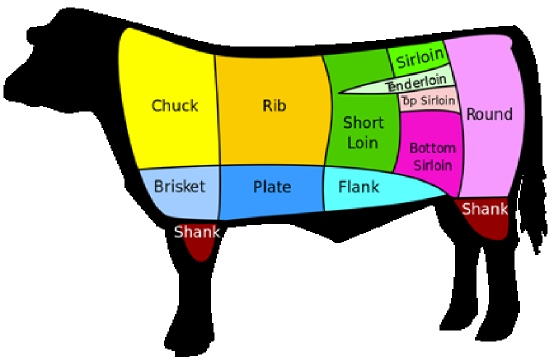
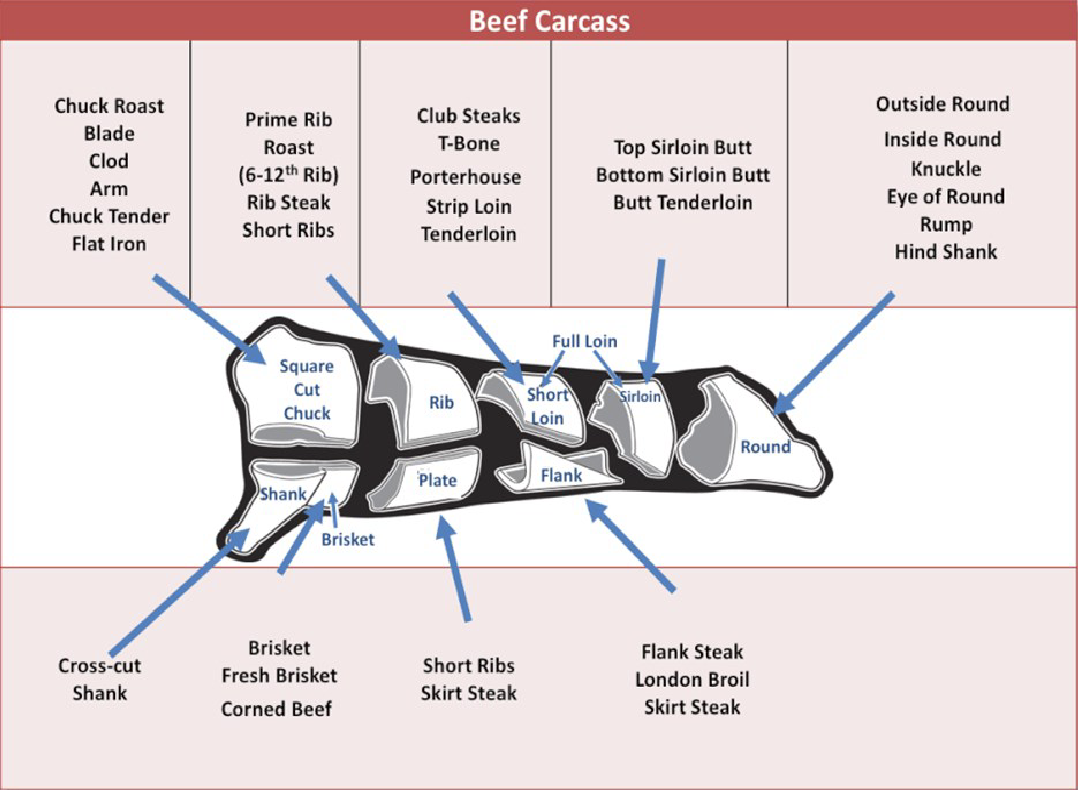
|
Beef Brisket
|
Primal: one of the eight primal cuts Meat Buyer’s Guide variations: 120, 120A, 120B, 120C Weight Ranges: 4 lb. -12 up. Best Cooking Methods: braising, slow cooking, smoking, stewing, pot roasting Common Cuts: Full Brisket, Flat, Point |
The cut of choice used by BBQ masters. Other uses: corned beef, pastrami, pot roast, and is common at Passover feasts. Beef Brisket is usually an inexpensive cut. |
|
Bottom Round
|
Primal: beef bottom round is part of the “round” primal cut Meat Buyer’s Guide variations: 170, 170A 171, 171A, 171B, 171C Weight Ranges: 3 lb. -31 up. Cooking Methods: braising, slow cooking, stewing, pot roasting Common Cuts: Gooseneck, Faux Filet Mignon, Chip Steak, Eye of Round |
Look for a short, thick piece with some fat left on it. The longer, leaner options are less desirable as they will be tougher while lacking flavor. The meat itself should have a bright, cherry-red color with fat speckled throughout the muscle. Check that the muscle is firm to the touch. |
|
Chuck Roast
|
Primal: beef chuck is a primary primal cut. Meat Buyer’s Guide variations: 113, 114A, 114B, 114C, 114D, 114E, 115, 115A, 115B, 115C, 116, 116A, 116B, 116C, 116D, 116E Weight Ranges: 1 lb. to 88 lb. Best Cooking Methods: braising, slow cooking, stewing, pot roasting Common Cuts: Square-cut Chuck, Cross-cut Chuck, Flatiron Steak, Shoulder Tender, Eye Roast, Under-Blade Steak |
The chuck is essentially a whole cow shoulder, also known as a clod, and when removed from the forequarter is called a cross- cut chuck. It weighs about 100 pounds, and makes up roughly 23% of the carcass. |
|
Prime Rib
|
Primal: beef prime is one a primary primal cut. Meat Buyers Guide variations: 104, 107, 107A, 108, 109, 109A, 109B, 109C, 109D, 109E, 110, 111, 112, 112A Weight Ranges: 3 lb. -30 up. Best Cooking Methods: slow cooking, roasting, grilling, broiling Cut Variations: roasts, steaks Best beef grades, from highest to lowest, are as follows: USDA Prime, USDA Choice, USDA Select, USDA Standard, USDA, Commercial. |
Prime Rib Cooking Temperatures
|
|
Beef Short Loin
|
Primal: beef short loin is a primary primal cut. Meat Buyers Guide variations: 173, 174, 175, 180, part of 172, and 172A. Weight Ranges: 14 lb. -57-up. Best Cooking Methods: slow cooking, roasting, grilling, broiling Cut Variations: roasts, steaks |
Home to various steaks that we all know and love — the Delmonico, the Porterhouse, the T- Bone — all of which are among the most tender, popular and expensive cuts of beef |
|
Tenderloin of Beef
|
Primal: beef tenderloin is part of the Loin Primal Cut Meat Buyers Guide variations: 189, 189A, 189B, 190, 190A, 191, 191A, 191B, 192, 192A Weight Ranges: 1 lb. – 7-up. Best Cooking Methods: roasting, grilling, broiling Cut Variations: roasts, steaks |
Beef tenderloin, akaFillet Mignon, is the tenderest cut of meat a cow. |
|
Top Sirloin
|
Primal: top sirloin is part of the “sirloin” primal cut Meat Buyer’s Guide variations: 184, 184A, 184B, 184C, 184D, 184E Weight Ranges: 1 lb. -14 up. Best Cooking Methods: roasting, grilling, broiling |
There are two varieties of sirloin steak available, from the sirloin primal, between the short loin primal (behind the ribs), and round primal (the rump). The bottom sirloin for ground meat, or cut it into chunks for stewing or braising |



